The Ultimate Pickleball Balls Guide: Everything You Need to Know in 2025

CEO & Technical Expert at Pickleball Equipment Company (Art Pickleball)
Specialize in manufacturing pickleball paddles, pickleball balls, and pickleball accessories.
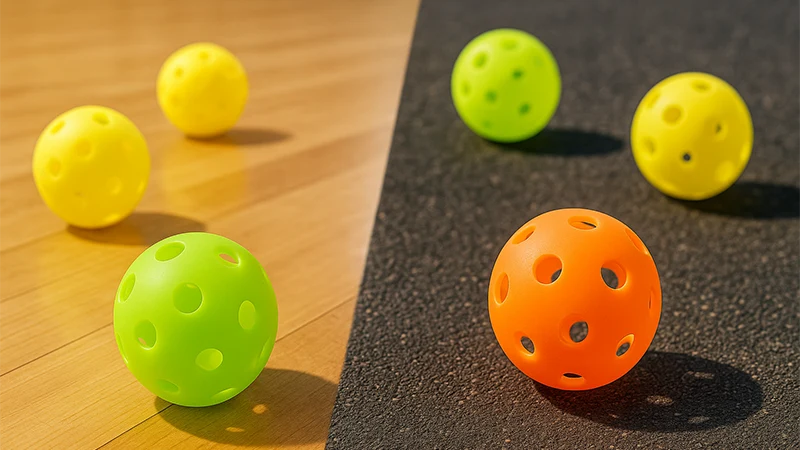
If you have ever wondered what kind of ball is used in pickleball, you are not alone. The sport is growing fast and players everywhere want to understand the gear. A pickleball ball looks simple at first glance: a hollow plastic sphere with holes. Yet the details matter more than most people think.
This pickleball balls guide will walk you through everything you need to know. You will find the official USA Pickleball specifications for size, weight, and bounce. You will see how indoor and outdoor balls differ, what materials are used, how long they last, and how to choose the right one. The guide also covers sourcing, from individual use to bulk orders for clubs and custom manufacturing for brands.
Think of this as your one stop reference. By the end, you will not only know what ball is used in pickleball. You will also understand why certain balls perform better, how long they last, and which ones are best suited for your game or your organization.
What Is a Pickleball Ball?
A pickleball ball is a lightweight, hollow plastic ball with evenly spaced holes across its surface. At first glance it looks a bit like a wiffle ball, but it is designed with much stricter specifications to make the sport playable at different skill levels and on different surfaces.
Unlike a tennis ball, which is made of pressurised rubber covered with felt, a pickleball has no internal pressure and no outer fabric. The result is a ball that bounces lower, moves slower, and creates rallies that are easier to sustain for players of all ages. This is one of the reasons why pickleball has become so popular with beginners and older players.
Compared to a wiffle ball, a pickleball is heavier, more durable, and built for predictable flight. Wiffle balls often curve dramatically in the air because of uneven hole placement. Pickleballs, on the other hand, use a balanced hole pattern that keeps the ball’s path straighter and more consistent.
How Big Is a Pickleball Ball?
Pickleball balls may look simple, but their size and performance are carefully regulated by USA Pickleball (USAPA). These rules make sure that every ball used in competitive play feels the same, no matter where the game takes place.
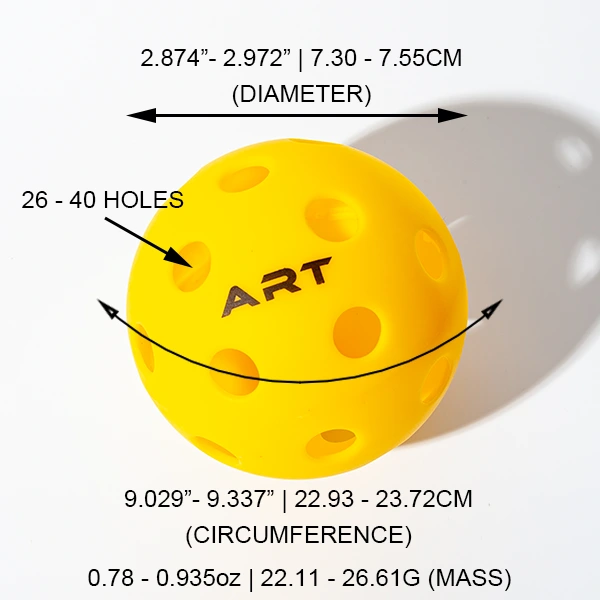
1. Diameter
An official pickleball must measure between 2.87 and 2.97 inches across. This makes it slightly larger than a tennis ball and easy to see during rallies.
2. Circumference
The ball’s total circumference falls between 9.03 and 9.34 inches, keeping it perfectly round for consistent flight.
3. Weight
Approved balls weigh 0.78 to 0.935 ounces. A lighter ball may float too much, while a heavier one can be difficult to control.
4. Bounce
When dropped from 78 inches onto a hard surface, the ball must rebound 30 to 34 inches. This ensures predictable play in every match.
5. Hardness
To pass certification, a pickleball must register 40 to 50 on the Durometer D scale at room temperature. This balance prevents balls from being too soft or too brittle.
Every ball that meets these measurements earns the USAPA Approved stamp. Recreational players may not always notice the difference, but for tournaments and club play, these standards keep the sport fair and consistent.
Indoor vs Outdoor Pickleballs
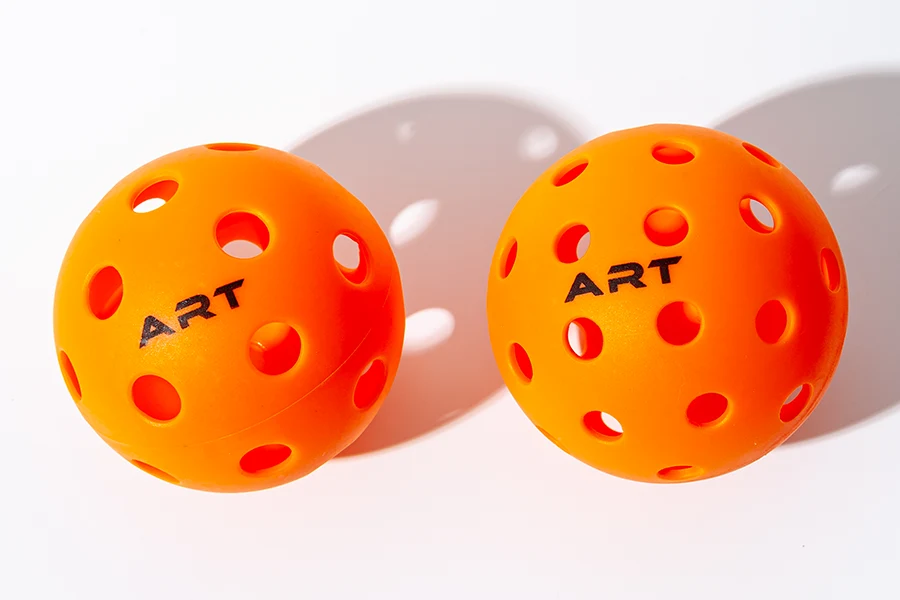
Not all pickleball balls are the same. The biggest split is between indoor and outdoor designs. Both must meet the same official size and weight standards, but their construction is adjusted for the conditions they face.
Indoor Pickleballs
- Typically have 26 larger holes.
- Made from a slightly softer plastic that offers better control and longer rallies.
- Produce less noise when hit, making them more suitable for gyms or multi-use facilities.
- More forgiving in play, but less durable if used on rough outdoor courts.
Outdoor Pickleballs
- Usually feature 40 smaller holes.
- Constructed from harder plastic so they can withstand wind, sun, and rougher surfaces like concrete or asphalt.
- Fly faster and bounce higher, which adds pace to the game but can also make rallies shorter.
- Louder impact sound, which some players find satisfying while others see as a drawback.
Comparison Table: Indoor vs Outdoor Pickleballs
| Feature | Indoor Balls | Outdoor Balls |
|---|---|---|
| Hole Count | 26 large holes | 40 small holes |
| Material | Softer plastic for control | Harder plastic for durability |
| Weight (range) | 22.1 g (0.78 oz) – 24 g (0.855 oz) | 25.5 g (0.9 oz) – 26.5 g (0.935 oz) |
| Diameter | 2.87″ (7.30 cm) – 2.89″ (7.36 cm) | 2.89″ (7.36 cm) – 2.97″ (7.55 cm) |
| Speed & Flight | Slower with more drag, stable in gyms | Faster flight, built to resist wind outdoors |
| Control & Spin | Easier to control and add spin to shots | Harder to control, spin is more difficult |
| Rallies | Long rallies are common, great for practice | Shorter rallies due to faster pace |
| Durability | Lasts longer indoors, wears quickly outdoors | Built to handle asphalt and concrete, but tends to crack sooner |
| Noise | Quieter, better for indoor facilities | Louder “pop” sound |
| Common Use | Gyms, community centers, casual and beginner play | Tournaments, outdoor clubs, competitive play |
Choosing Between Them
Most players own both indoor and outdoor pickleballs. Using the right ball for the surface keeps the game fair and enjoyable. Clubs and event organizers often buy large batches of each so players can practice and compete in the right conditions.
For a deeper look, see our full guide: 5 Key Differences Between Indoor and Outdoor Pickleball Balls.
Pickleball Ball Types
Not all pickleball balls are made for the same purpose. Depending on where and how you play, you will find different types of balls that suit your needs. Here are the main categories.
Recreational Balls
These are designed for casual play in backyards, driveways, or community centers. Recreational balls are affordable and easy to find, but they may not last as long as higher quality options. They are perfect for beginners who are learning the game.
Tournament-Approved Balls
If you plan to play competitively, you will need USAPA-approved balls. These meet the official size, weight, bounce, and hardness standards required for tournaments. They deliver consistent performance and are trusted by clubs and leagues worldwide.
Training Balls
Coaches and clubs often use practice balls to help players build skills. Training balls can be slightly softer or lower bounce, making them easier for drills and extended rallies. Some even come in brighter colors to improve visibility during lessons.
Specialty Balls
There are also niche options made for unique conditions:
- Quiet balls for noise-sensitive environments like indoor gyms or residential areas.
- Foam balls that are lightweight and safe for kids or indoor training without the loud “pop” sound.
- Glow or LED balls designed for night games or special events, adding a fun twist to recreational play.
Each type of ball serves a different audience, from new players to competitive athletes. Choosing the right one depends on your goals and the environment you play in.
What Are Pickleballs Made Of?
Watch how injection and rotational molded pickleball balls are made in our factory.
Here’s a behind-the-scenes look at how pickleball balls are manufactured.
Pickleball balls are made from durable plastic materials, most commonly polypropylene. This type of polymer is strong, lightweight, and resistant to cracking, which makes it ideal for both indoor and outdoor use. Some recreational balls may use other plastics, but polypropylene has become the standard for high quality balls.
Beyond material, the way a pickleball is produced also affects how it performs. Most balls are injection molded in two halves, then fused together. This process leaves a visible seam but allows for mass production at a consistent size and weight. However, injection molded balls can sometimes have uneven wall thickness, which may affect flight or durability over time. Learn more about injection molded pickleball balls.
A smaller group of premium balls use rotational molding. This method creates a one piece ball without a seam and with uniform wall thickness. The result is better balance, improved durability, and more consistent bounce. These balls are often preferred by serious players and clubs even though they are more expensive to produce. See options in our rotational molded pickleball balls.
Durability and Lifespan
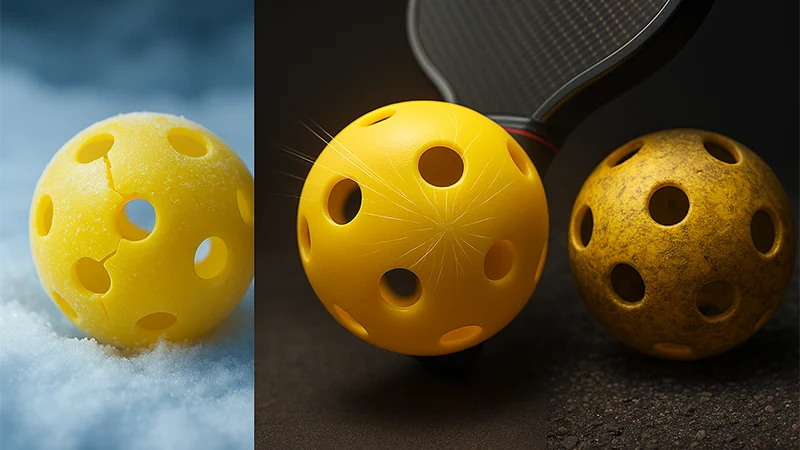
Pickleball balls are not built to last forever. On average, a ball will hold up for 4 to 10 games before it begins to show signs of wear. Some may last longer in casual play, while others can crack or lose bounce more quickly under intense conditions.
Several factors affect durability:
- Weather: Cold temperatures make the plastic more brittle and increase the chance of cracking. Hot weather can soften the material and change the way the ball bounces.
- Playing style: Hard hitters and frequent smashes put more stress on the ball, which shortens its lifespan.
- Court surface: Smooth indoor gym floors are gentler, while rough outdoor surfaces like asphalt or concrete wear balls down faster.
How to Choose the Right Pickleball Ball
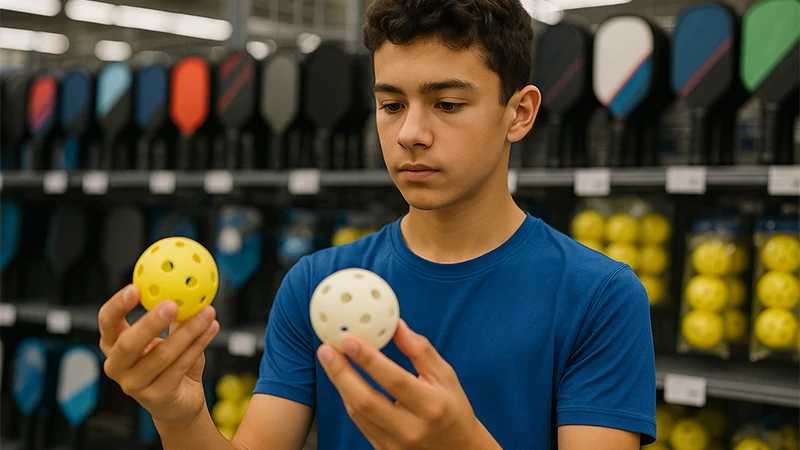
With so many options available, choosing the right pickleball ball comes down to matching the ball to your playing environment and needs.
Indoor vs Outdoor
Start with where you play. Indoor balls with larger holes are slower and easier to control, making rallies longer and better for learning or casual games. Outdoor balls with smaller holes are faster, louder, and built to withstand rougher surfaces and wind. Most players who compete own both types so they can switch depending on the court.
USAPA-Approved vs Recreational
If you plan to enter tournaments or run club matches, you need USAPA-approved balls. These are tested for size, weight, bounce, and hardness to guarantee consistent performance. Recreational balls are fine for practice or casual play, but they may not behave the same way as official models. For clubs and coaches, practicing with approved balls helps players build habits that transfer directly to competition.
Durability and Performance
Durability varies by brand and construction. Premium balls made with better plastics or rotational molding last longer and keep a truer bounce. Budget balls are cheaper but may crack quickly, especially outdoors. For organizations that purchase in bulk, balancing cost and lifespan is key to maintaining both player satisfaction and budget efficiency.
Popular Models
For outdoor play, many professionals use the Onix Dura Fast 40 or the Franklin X-40. Both are USAPA-approved and widely used in high-level tournaments. They serve as benchmarks when evaluating other brands, including custom or bulk options for clubs.
Buying Guide – Retail and Bulk Sourcing
Finding the right pickleball balls is not only about type and performance. You also need to know where to get them. The buying process looks different for individual players compared to clubs or brands.
Retail Options
Casual players can find pickleball balls at most sporting goods stores or through major online marketplaces. Packs are usually sold in sets of 3, 6, or 12. This works well for players who just need a few balls for practice or friendly games.
Bulk Purchasing for Clubs and Events
Clubs, schools, and tournament organizers often purchase balls in bulk quantities. Ordering larger packs reduces the cost per ball and ensures that events run smoothly with fresh, consistent equipment. Bulk sourcing is the most practical option for organizations that go through dozens of balls each week.
OEM and Custom Solutions
For brands or organizations that want a unique edge, OEM and ODM manufacturing can provide custom colors, logos, or packaging. This approach is ideal for companies building their own pickleball lines or clubs that want branded equipment. As a manufacturer, we help partners create pickleball balls that meet USAPA standards while also reflecting their brand identity.
Popular Models
For outdoor play, many professionals use the Onix Dura Fast 40 or the Franklin X-40. Both are USAPA-approved and widely used in high-level tournaments. They serve as benchmarks when evaluating other brands, including custom or bulk options for clubs.
Conclusion
Choosing the right pickleball ball comes down to environment, durability, and whether you need tournament approval. Indoor balls give control, outdoor balls bring speed, and both play an essential role in the game. For bulk orders or custom solutions, explore our custom pickleball balls to find the right fit for your club, event, or brand.
FAQs About Pickleball Balls
1. What kind of ball is used in pickleball?
Official pickleball balls are made of hard plastic, with a diameter of 2.87–2.97 inches and weight of 0.78–0.935 ounces. USAPA-approved balls meet these specs for competitive play.
2. How many holes are in a pickleball?
A pickleball can have between 26 and 40 holes. Indoor balls usually have 26 larger holes for better control, while outdoor balls use 40 smaller holes to resist wind.
3. Why do pickleball balls have holes?
The holes reduce air resistance and slow the ball’s flight. This makes rallies easier to control and allows players of all ages to enjoy the game without overwhelming speed.
4. What colors are pickleballs?
Pickleballs come in bright colors for visibility, with yellow, green, orange, and white being the most common. Tournament balls must be a uniform color but no single shade is mandated.
5. Are pickleballs the same as wiffle balls?
No. While they look similar, pickleballs are heavier, more durable, and have evenly spaced holes. Wiffle balls curve unpredictably, while pickleballs fly straighter and bounce consistently.
| Feature | Pickleball Ball | Wiffle Ball |
|---|---|---|
| Hole Design | 26–40 round holes, evenly spaced for stable flight | 18–26 oval holes, placed on one side, causing uneven airflow |
| Material | Made from durable, high-quality plastic for repeated play | Lightweight thin plastic, intended mainly for casual backyard games |
| Weight | 22–26 g (0.78–0.93 oz), heavier for more predictable performance | Around 20 g (0.70 oz), lighter and less stable in windy conditions |
| Size (Diameter) | About 2.87″ to 2.97″ (7.3–7.55 cm), within USAPA competition standards | About 2.87″ to 2.97″ (similar size but without competitive standards) |
| Bounce | Consistent rebound suitable for rallies and tournaments | Irregular bounce that varies depending on impact angle |
| Durability | Built to handle indoor courts and outdoor surfaces like asphalt or concrete | Less durable, tends to crack or lose shape after limited use |
| Visibility | Produced in bright, high-visibility colors for better tracking during play | Typically white, harder to see in varied lighting |
| Flight & Control | Straight and predictable trajectory, designed for accuracy and long rallies | Often curves in flight, harder to control for consistent gameplay |
| Typical Use | Official sport equipment for recreational play, clubs, and professional matches | Backyard fun, casual play, and family activities |
6. Pickleball ball vs tennis ball – size and bounce
Pickleballs are slightly larger than tennis balls but weigh less. They bounce lower and slower, creating longer rallies and a very different feel from the high-speed pace of tennis.
7. How fast do pickleballs travel?
Most shots range from 20 to 40 mph. Professional smashes can approach 60 mph, which is still much slower than tennis. This speed helps keep the sport accessible and fun.
8. Do kids and adults use the same balls?
Yes. All ages use the same official pickleball balls. The slower speed and lighter weight make them easy for children to handle, while still suitable for competitive play.
9. How long do pickleballs last?
On average, a pickleball lasts 4 to 10 games. Cold weather, heavy hitting, and rough surfaces shorten lifespan, while indoor play on smooth courts extends it.
10. Can you use indoor balls outdoors?
You can, but it is not ideal. Indoor balls may feel too light and wear out quickly on asphalt or concrete. Outdoor balls are tougher and designed to handle wind and rough surfaces.
